The complexity of The Goonies definitely peaks early – level three brings you to the game’s midpoint, but nothing that follows this stage comes anywhere close to the intricacy of this one.
Consisting of seven different areas spread across the “front” and “back” portions of the map, stage three sprawls in a far less linear fashion than its predecessors, offering multiple routes through the caverns. It also offers two different exits, one of which is a warp that allows you to skip level four entirely. As the level covers so much ground, the assorted secrets scattered here are placed far more loosely throughout the stage, forcing you to hunt much more carefully than in previous levels.
Stage three incorporates all the hazards of previous levels and introduces a new one: The ghost of One-Eyed Willy, who materializes at semi-random locations to drift horizontally from where he first appears. You can’t defeat the ghost with karate kicks, needing instead to leap over him. But! You can defeat him with the slingshot. No, I don’t know how that works, either.
Unlike in previous stages, you don’t uncover secrets by ducking or kicking. Instead, you press up at select locations to reveal hidden objects. Once again, this change in mechanics is demonstrated by the presence of diamonds adjacent to ladders, so that you’ll expose it as you climb to a higher level and (hopefully) deduce to mechanic behind its appearance. While The Goonies isn’t always the friendliest game, the way it makes conspicuous efforts to present its mysterious inner workings in a seamless fashion deserves a nod. In this stage, diamonds appear twice by ladders, to help ensure you don’t miss the trick.
Two new hazards appear in the scenery as well: Stalactites, which fall when Mikey draws near, and puffs of steam that blast out from the various pipes that define the scenery here (presumably modeled after the bit in the movie where they end up in a nest of pipes below the country club). The latter are totally harmless if you managed to find the raincoat in level two; otherwise you need to duck at regular intervals to avoid flying steam puffs. The former initially prove to be something of a hazard if you run forward recklessly, but hidden within this stage you can find a football helmet that makes Mikey invulnerable to falling chunks of rock. At this point, you’ll be wearing an asbestos suit beneath a raincoat, capped by a helmet. Mikey is quite a sight.
The difficulty in this stage simply comes from covering all the available territory within the six minutes’ time you’re allowed for exploration. Or, alternately, from covering all the available territory within the six minutes’ time as you avoid falling stalactites and jets of steam.
It’s about here that the importance of The Goonies‘ hidden items really makes itself evident. You can beat the game without ever finding them, I’m sure, but your survivability greatly increases once you discover their locations. Again, this fits neatly within the trends of the era, as many games emphasized the discovery of infuriatingly well-hidden objects in order to facilitate progression. Compared to something like Milon’s Secret Adventure, though, The Goonies plays well despite the opacity of its secrets.
Tools become something of a difficulty select; if you have them, it’s a fairly straightforward platformer with a moderate emphasis on exploration. Without them, it becomes a very challenging action game the requires sharp reflexes and steely nerves. Tellingly, the second loop of the game (once you complete the sixth stage) goes about implementing the obligatory added difficulty by making items ludicrously difficult to acquire: Instead of kicking or pressing up to reveal them, you have to drop bombs where they appear. Because of the slim time limits, you really have to strategize and know which items are most essential, or else bypass them altogether. (Not to mention having their locations memorized.)
The fourth stage plays much like the first, though it covers considerably less ground. You can acquire all the items in this stage pretty quickly; the challenge comes from timing your movements around the new hazard, the stone counterweights that rise and fall in a steady rhythm.
Also, for that extra touch of maddening abuse, hidden items in this stage appear only when you press down plus attack. Yes, this is the same button combo that places a bomb, but bombs aren’t the trigger – it’s the act of pressing the buttons. So you can find items without bombs, but while searching you’ll be wasting any bombs you’ve collected. On the other hand, one of the hidden tools here is a backpack that allows you to carry two bombs at once.
On the other hand, you can completely skip stage four altogether. That means you’ll bypass the backpack and also the useful red suit item (which nulls the effect of bomb blasts). They’re handy items, but you can live without them.
How this works: If you’ve collected the spring shoes item in stage three, Mikey suddenly gains the ability to perform high jumps on this screen. Only on this screen. This ability is not communicated in any way – there’s no music, visual effect, audio cue, or other indication that suddenly you’ll jump three times as high as usual once you climb down to this screen. You really have to dig deep to discover this particular shortcut.
That being said, it’s a pretty smartly placed shortcut. Completing stage three allows you collect all the items that counter environmental hazards – falling rocks, water, fire – and bypass an entire level that places a heavy emphasis on high-damage dangers that can’t be countered as well as extensive platforming. And the game designers still accounted for your ultimate goals if you do take the warp: Stage four’s trapped Goonie appears instead in the single vault that shows up along the warp route. You can still get the proper ending to the game without having to slog through the entire fourth stage. This is definitely a trick meant for advanced players who have wrung the game’s secrets inside and out…
…but then, in 1986, that was basically the only demographic. Most kids didn’t buy tons of games like people do today; since games cost so much more (and so many fewer existed), kids picked up a game every once in a while and played them over and over again. The Goonies‘ frequently counterintuitive design, as in so many games of the era, reflected the habits of its audience. You weren’t meant to suss all the secrets in your first go ’round, because then what would there be to do the next 50 times you played? While I’m not saying this approach to design is above reproach, it does at least have purpose.
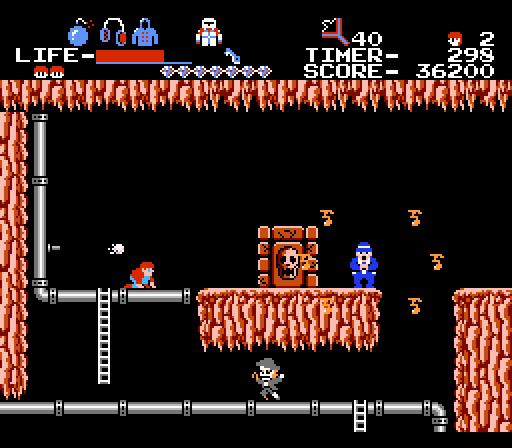
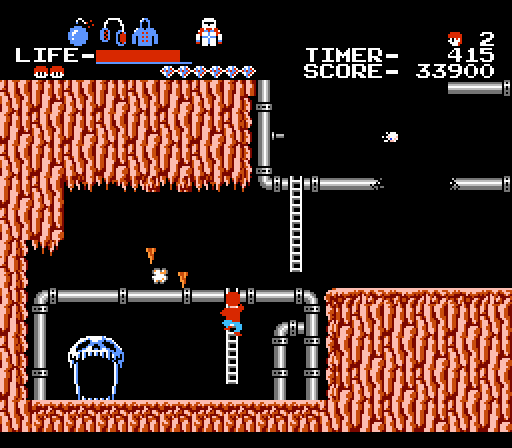
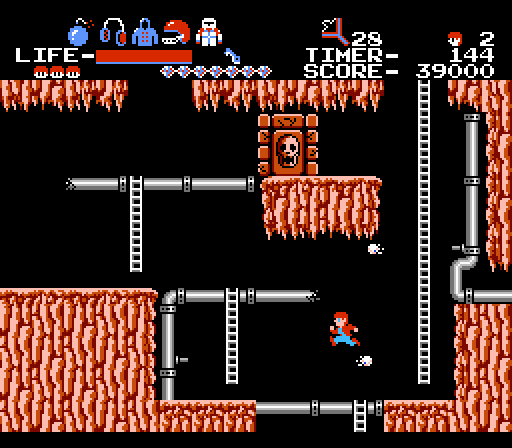
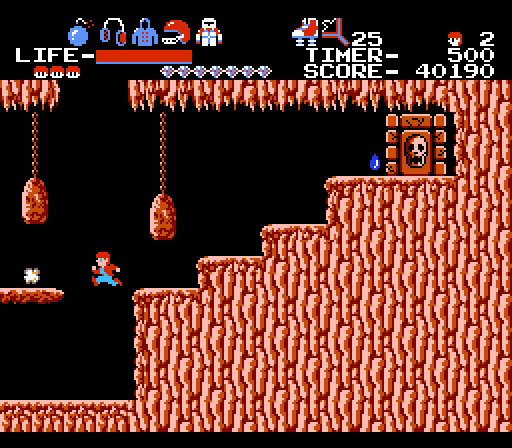
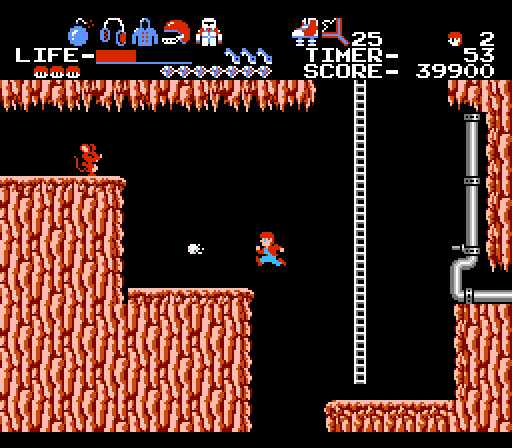
I’m really enjoying this series. With the Super Mario Bros. series of articles, the Castlevania ones, these articles, and now the Mega Man articles, it’s very interesting to see how different companies and developers were all working on the same types of 2D platformer concepts but chose to implement them differently.
It’s a shame people aren’t more familiar with this game because it never got a home NES release. I’m very excited to see how you take on The Goonies II. Even thinking about how I would approach breaking down that game gives me a headache.